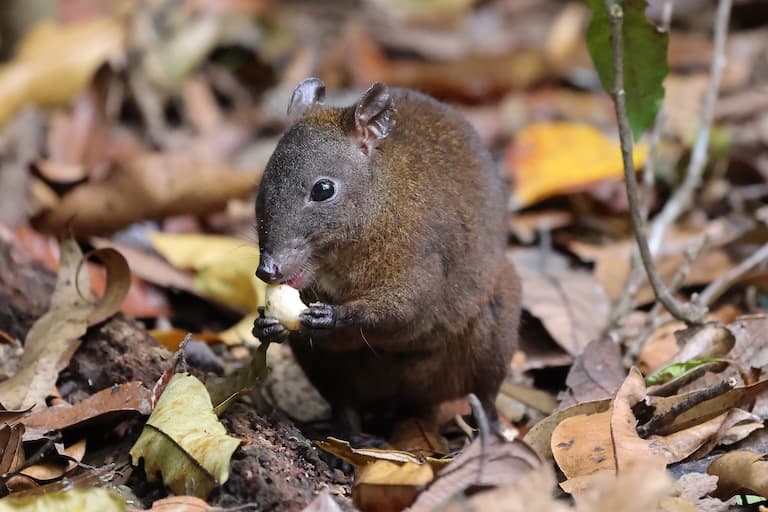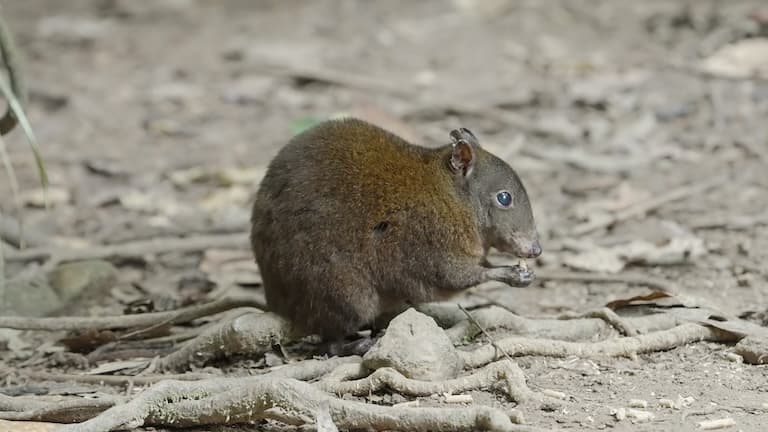Musky Rat-Kangaroo Profile
Kangaroos began their evolutionary path as some kind of arboreal opossum. They then descended from the trees, grew huge feet, and while some of them decided to go back up, many stayed on the ground, diversifying into the wallabies, potaroos, and other such macropods we see today.
One species, the musky rat-kangaroo, is thought to be the oldest form of macropod, and as such, retains some primitive features, as well as some unique characteristics of its own.

Musky Rat-Kangaroo Facts Overview
| Habitat: | Tropical rainforest |
| Location: | North-eastern Australia |
| Lifespan: | Unknown |
| Size: | Around 35 cm (1 ft) long with a 12 cm (4.5 in) tail |
| Weight: | Up to 680 g (24 oz) |
| Colour: | Brown or rusty grey, lighter underneath |
| Diet: | Mostly insects, also worms, tuberous roots and palm berries. |
| Predators: | Unknown, likely feral cats and dogs |
| Top Speed: | Nippy |
| No. of Species: | 1 |
| Conservation Status: | Least Concern (IUCN) |
Musky rat-kangaroos are the smallest and likely most ancient species of macropod. They’re quite different from the others in a number of ways, including their preference for daylight, their strange gait and their unusual sperm.
These forest specialists eat more or less anything they can find, and this appears to be serving them quite well, as despite ongoing habitat destruction, their populations remain at a comfortable number.
Interesting Musky Rat-Kangaroo Facts
1. They’re living fossils
The genus Hypsiprymnodon only contains one extant species, though four others are known from the fossil records.
It’s thought to be the closest thing we’ve got to the ancestral opossum that once descended from the trees to become the macropod line.
The musky rat-kangaroo is a true survivor, alone in this genus, not all that related to the macropods around it, despite resembling a potoroo quite closely.
But looks can be deceiving, and to figure out an animal’s evolutionary relationships, sometimes you have to get a much closer look. Perhaps even uncomfortably close. 1
2. You can tell by their sperm
If you wanted to find out who knocked over your shiny new Honda Rebel you might use the greasy little prints left on the fuel tank.
Fingerprints are distinct enough between humans that they can be reliably used to identify individuals, but if you were trying to identify the evolutionary history or phylogeny of the ratbag, prints won’t cut it.
Baboons (the ratbag’s closest relative) have prints that would be hard to tell apart from those of humans, for example, but even Koalas, animals whose genetic commonality with ours diverged before placentas were invented around 170 million years ago, have prints like us.
These prints evolved independently of ours, which means their presence isn’t a good indicator of our relationship.
That’s because fingerprints, for whatever reason, are good evolutionary solutions to environmental problems, and can arise convergently in two unrelated species if those species happen to be faced with similar problems.
The inner workings of sperm cells, on the other hand, aren’t generally under the same evolutionary pressure and evolve far more precisely as a result of an individual’s evolutionary path than the selective pressure their environment puts on them.
This makes them akin to a fingerprint, but one that identifies an ancient lineage.
So, there’s a whole branch of research dedicated to eyeballing collected sperm as close up as possible, using electron microscopes to find these distinctive characteristics and map the path of species over evolutionary time.
3. They’re the smallest kangaroo
“Kangaroo” is not a strictly taxonomic term. It’s predominantly reserved for the four largest species of macropod, beneath which you get the wallabies, and the intermediate wallaroos, pademelons and the whole jumble of classic Australian gibberish.
But it swings around again at the bottom of the spectrum with the rat kangaroos, whose bald tails give them the rodentine epithet but membership of the Macropod suborder allows them the title of Kangaroo. And these are the smallest of the Macropodiformes, at a mere 500 g in weight.
But this isn’t the only way these funny little animals differ from their kin. 2
4. They have a lot of toes
No other macropod has such a well-developed first digit on its foot. This little kangaroo doesn’t have a lot of dexterity in this digit, and it’s not opposable to the other toes, but it exists where nothing does in the other species, giving it the ability to count to ten – two more than the others.
It also has a bare, scaly tail, which is another thing that sets it apart, as is its preference for being about during the day.
These extra features may help it walk in a way not commonly associated with macropods, too.

5. They walk funny
In most larger macropods, the tail is used as a fifth limb, supporting the animal’s locomotion. Not so with the musky rat kangaroo! These tiny ‘roos walk uniquely, too, with a slow gait, forepaws placed gently and hind legs brought up to meet them in unison.
The tail is held out behind it, and even when they’re in a hurry, all four limbs are used, unlike the rapid springing of the kangaroos and their kind.
6. They eat everything
Yet another unusual feature of this animal is its diet. Most macropods are herbivorous, either exclusively or primarily, but the musky rat-kangaroo eats a whole load of worms and caterpillars and other invertebrates, too.
It’s still keen on fruit, though, and these animals are thought to be significant seed dispersers in the forest as a result.

7. They’re doing pretty well
These small, solitary animals aren’t all that well documented but it’s thought that they face no severe threats currently.
Invasive species like cats and dogs present a problem, as does the slow decay of viable habitats at the hands of human expansion, but neither of these pressures seems particularly imminent as of yet.
Its former range has been reduced, but the species as a whole is still listed as least concern. 3
Musky Rat-Kangaroo Fact-File Summary
Scientific Classification
| Kingdom: | Animalia |
| Phylum: | Chordata |
| Class: | Marsupiala |
| Order: | Diprodontia |
| Family: | Hypsiprymnodontidae |
| Genus: | Hypsiprymnodon |
| Species: | moschatus |
Fact Sources & References
- “Hypsiprymnodon moschatus musky rat kangaroo”, Animal Diversity Web.
- S. Lloyd (2022), “Ultrastructure of the mature spermatozoon of the musky rat-kangaroo, Hypsiprymnodon moschatus (Potoroidae: Marsupialia)”, Wiley Online Library.
- “Musky Rat Kangaroo”, ICUN Red List.
